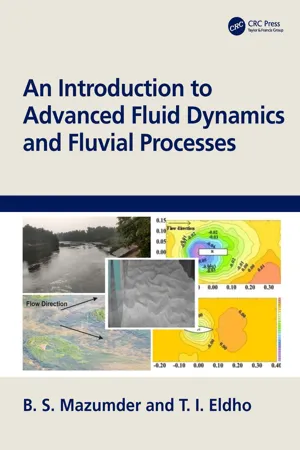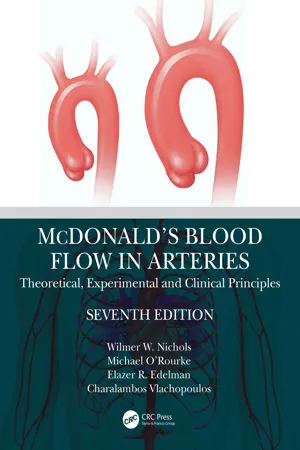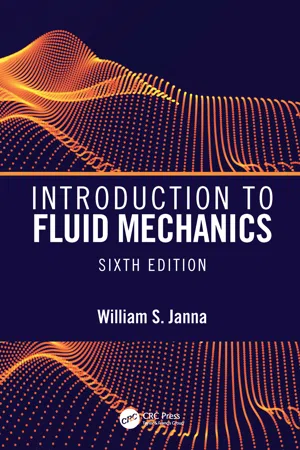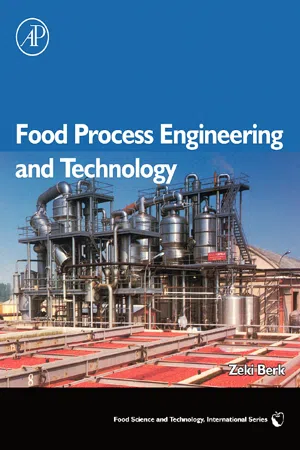Physics
Fluids
Fluids are substances that flow and take the shape of their container. They include liquids and gases, and their behavior is described by fluid dynamics. Key properties of fluids include density, viscosity, and pressure. Fluids play a crucial role in various physical phenomena, such as hydrodynamics, aerodynamics, and buoyancy.
Written by Perlego with AI-assistance
Related key terms
10 Key excerpts on "Fluids"
- eBook - ePub
Doing Physics with Scientific Notebook
A Problem Solving Approach
- Joseph Gallant(Author)
- 2012(Publication Date)
- Wiley(Publisher)
Chapter 10Fluids
A fluid is something that can flow and take the shape of its container. In the non-physics world, fluid and liquid are synonymous but here in physics-land both gases and liquids are Fluids. Understanding Fluids is useful and important. We live on a planet with an atmosphere, so we live at the bottom of a giant pool of a fluid we call air. Our bodies are mostly water so we are made of mostly Fluids.Density and Pressure
Density is an important property of a fluid. Density is mass per unit volume, so it is a measure of how much stuff (mass) occupies how much space (volume). A pound of feathers and a pound of lead have the same weight and mass, but the feathers are less dense so they take up more space than the bricks. A liter of water and a liter of mercury have the same volume, but the mercury has more mass because it’s denser.A substance of mass m that occupies volume V has density ρ.(10.1)The metric unit of density is kg/m3 although g/cm3 is also used.Density is a physical property of a substance (see Table 10.1 at the end of the chapter). Gases usually have the smallest density, solids have the largest density, and most liquids are in between. The density of water is ρw= 1000 kg/m3 . Let’s see how much space 1 kg of water takes up.That’s one liter! A small bottle holds a kilogram of water.table 10.1Example 10.1Ugly bags of mostly waterThe average male human has a mass of 76.0 kg and a density of about 1046 kg/m3 . What is his volume? Give your answer in liters.Solution.Use Eq. (10.1) to create and Evaluate the following expression that gives the volume in liters.The average male has a volume equivalent to almost 73 small bottles of water.Pressure is an important process that determines the behavior of a fluid. Pressure is force per unit area so it is a measure of how hard you push (force) and how spread out the push is (area). You can change the pressure by changing the applied force or the area of its application. - eBook - ePub
- A. L. Stanford, J. M. Tanner(Authors)
- 2014(Publication Date)
- Academic Press(Publisher)
9 Mechanics of Fluids Publisher Summary This chapter describes the properties of Fluids that permit an analysis of their mechanics and the introduction of pressure, a quantity that is useful in considering the way in which forces may affect Fluids and in which Fluids exert forces. A practical application of fluid statics is the use of Pascal’s law, which treats the transmission of pressure in confined Fluids (hydraulic systems). At the microscopic level, all matter is composed of particles that are constantly in random motion. The particles in a solid are strongly bound together; their random motion is confined to jiggling about equilibrium positions that are virtually fixed relative to each other. Thus, solids are relatively rigid. The particles in a gas essentially interact only during brief, intense collisions with other particles of the gas or with the walls of their container. The motion of particles in a liquid is random but not as chaotic as the motion of particles of a gas. The attractive forces between particles in a liquid are sufficiently strong on the average to make the liquid cohesive yet are weak enough to permit the liquid to flow. In flowing, the particles of the liquid pass one another easily without macroscopic separation of the mass of liquid. Fluids are either liquids or gases. They are characterized by physical properties that distinguish them from solids. In this chapter we will first describe the properties of Fluids that permit us to analyze their mechanics and then introduce pressure, a quantity that is useful in considering how forces may affect Fluids and how Fluids exert forces. Pressure will be useful in studying fluid statics, that is, Fluids at rest, as contrasted with fluid dynamics, the study of Fluids in motion. Fluid statics entails the interaction of Fluids with their containers, with other Fluids, and with solids. Included in the study of statics is the physics of buoy ancy, a practical aspect of fluid studies - B. S. Mazumder, T. I. Eldho(Authors)
- 2023(Publication Date)
- CRC Press(Publisher)
2 Fundamental Fluid Properties and DefinitionsDOI: 10.1201/9781003000020-22.1 Introduction
Fluid mechanics is a branch of physics concerned with the mechanics of fluid flows. The study of fluid flow has been described with the support of fundamental laws of mechanics (Schlichting, 1968) . It has a wide range of applications in almost all branches of engineering fields including civil engineering, mechanical engineering, chemical engineering, aerospace engineering, agriculture engineering, ocean engineering, and others. Apart from the engineering profession, the principles of fluid mechanics are also used in all branches of sciences such as geophysics, astrophysics, physical chemistry, biomechanics, biomedical, meteorology, atmospherics, etc. It is one of the fastest rising basic sciences whose principles show applications in all aspects of daily life. For example, in civil engineering, the principles of fluid mechanics are used to design drainage systems, water networks, water-resisting structures such as dams and reservoirs, construction and foundation of bridge piers, river bank protection, river management, protection of coastal and harbor areas, etc. Moreover, designs of various types of ships, recreation boats, and barges or vessels for transportation in rivers and oceans associated with the field of naval architecture are based on the principles of fluid mechanics.The study of fluid behavior can be divided into three categories: statics, kinematics, and dynamics. In the static case, the fluid elements are acted upon by the forces at rest. The static pressure forces on an immersed body in fluid are determined from the static analysis. In the case of kinematics of Fluids, it deals with the geometry of fluid motion: study of translation, rotation, and deformation of fluid particles. This is useful for describing the motion of a particle and visualizing the flow patterns. In the dynamic case, the analysis involves considering the forces acting on the fluid particles in motion with respect to one another that cause acceleration of fluid. To determine the fluid flow pattern and its surroundings in motion, the dynamic analysis of a fluid in motion is required. In this chapter, the description of fundamental fluid properties and a fundamental definition of various terms used in fluid dynamics and fluvial hydraulics are briefly discussed.- eBook - ePub
- D. Kumar, Sarhan M. Susa(Authors)
- 2022(Publication Date)
- Mercury Learning and Information(Publisher)
5FLUID MECHANICSFluid Mechanics is basically a study of thei. physical behavior of Fluids and fluid systems, and of the laws governing this behavior,ii. action of forces on Fluids and of the resulting flow pattern.Fluid mechanics may be divided into three divisions:1. Hydrostatics that studies the mechanics of Fluids at absolute and relative rest; the fluid elements are free from shearing stresses.2. Kinematics that deals with translation, rotation, and deformation of fluid elements without considering the force and energy causing such a motion.3. Dynamics that prescribes the relations between velocities and accelerations and the forces which are exerted by or upon the moving Fluids.After reading this chapter, the reader would be able toi. make distinction between the three states of matter (solid, liquid, and gas).ii. understand the concept of a fluid, real and ideal fluid.iii. make a brief review about the development of the exciting and fascinating subject of fluid mechanics.iv. appreciate the unlimited practical applications of fluid mechanics.5.1. SOLIDS, LIQUIDS, AND GASESMatter exists in two principal forms: solid and fluid. Fluid is further subdivided into liquid and gas. Distinguishing features among these are as follows:i. The solids, liquids, and gases exhibit different characteristics on account of their different molecular structure. Spacing and the latitude of the motion of molecules are large in a gas, small in a liquid, and extremely small in a solid. Accordingly, the inter-molecular bonds are very weak in a gas, weak in a liquid, and very strong in a solid. It is due to these aspects that solid is very compact and rigid in form, liquid accommodates itself to the shape of its container, and gas fills up the whole of the vessel containing it.ii. For a given mass, the liquids have a definite volume irrespective of the size of the container. The variation of volume with temperature and pressure is insignificant. Liquid occupies the vessel fully or partially depending on its mass, and it forms a free surface with the atmosphere. The gas, however, expands to fill any vessel in which it is contained and does not form any free surface. Accordingly, it may be stated: The solid has volume and shape; a liquid has volume but no shape; a gas has neither - No longer available |Learn more
MCAT Physics and Math Review 2024-2025
Online + Book
- (Author)
- 2023(Publication Date)
- Kaplan Test Prep(Publisher)
Suboceanic lakes and rivers present a particularly fascinating opportunity to illustrate the physics of Fluids and solids. This chapter covers the important concepts and principles of fluid mechanics as they are tested on the MCAT. We will begin with a review of some important terms and measurements, including density and pressure. Our next topic will be hydrostatics, the branch of fluid mechanics that characterizes the behavior of Fluids at rest. We’ll then turn our attention to fluid dynamics, including Bernoulli’s equation and the aerodynamics of flight. Finally, the chapter concludes with a discussion of fluid dynamics in physiology, examining the properties that motivate the movement of blood and air within the body.4.1 Characteristics of Fluids and Solids
LEARNING OBJECTIVES
After Chapter 4.1, you will be able to:- Predict when gauge pressure will be equal to fluid pressure for a column of fluid
- Relate weight and density for an object
- Recall the common units for pressure, as well as the equations for gauge pressure and absolute pressure
Fluids are characterized by their ability to flow and conform to the shapes of their containers. Solids, on the other hand, do not flow and are rigid enough to retain a shape independent of their containers. Both liquids and gases are Fluids. The natural gas (methane) that many of us use to cook flows through pipes to the burners of our stove and ovens, and the air that we breathe flows in and out of our lungs, filling the spaces of our respiratory tract and the alveoli.Fluids and solids share certain characteristics. Both can exert forces perpendicular to their surface, although only solids can withstand shear (tangential) forces. Fluids can impose large perpendicular forces; falling into water from a significant height can be just as painful as falling onto a solid surface.Density
All Fluids and solids are characterized by the ratio of their mass to their volume. This is known as density, which is a scalar quantity and therefore has no direction. The equation for density isρ =Equation 4.1m Vwhere ρ (rho) represents density, m is mass, and V is volume. The SI units for density arebut you may find it convenient to usekg,m 3g mLorboth of which may be seen on the MCAT. Remember that a milliliter and a cubic centimeter are the same volume. A word of caution: students sometimes assume that if the mL and the cm3 are equivalent, then so must be the liter and the m3 . This is absolutely not the case; in fact, there are 1000 liters in a cubic meter. For the MCAT, it is important to know the density of water, which isg,cm 31g= ` 1000cm 3kg.m 3 - eBook - ePub
- Charles Liu(Author)
- 2020(Publication Date)
- Visible Ink Press(Publisher)
Fluids
What is a fluid?
Solid objects retain their shape because strong forces hold the atoms in their places. In a liquid, the forces keep the atoms close together, but they are free to move. In a gas, the atoms are about ten times farther apart than in either solids or liquids, and forces between them are very weak. As a result of weaker forces, a liquid or gas can flow freely and assume the shape of its container. Both liquids and gases are called Fluids. The study of Fluids in a state of rest (static Fluids) or in motion is called fluid mechanics, and the study of the movement of Fluids is called fluid dynamics.WATER PRESSURE
What is pressure?
Pressure is a measure of force exerted divided by the area over which it is exerted. You can exert pressure, for example, by pressing your hand against a surface, like a table or wall. You feel water pressure when you go into a swimming pool. Your body is experiencing air pressure all the time, although you might not feel it. One very important physical principle is that any volume of liquid, such as water, exerts equal pressure in all directions.What is Pascal’s Principle, and how does it work?
In 1647 the French scientist Blaise Pascal (1623–1662) recognized that liquids, like water, exert the same pressure in all directions. This statement is known as Pascal’s Principle.To understand Pascal’s Principle, think of a small cube of water, as shown in Figure 12 . The gray arrow in the middle is the force of gravity on the cube. As a result of gravity, the total downward force of the cube is larger than the upward force.Now by Newton’s Third Law, the outward force of the water is equal to the inward force on the water. What exerts this force on the water? If the cube is at the edge of the container, then the container exerts the force. You can check that for yourself. Use an empty fluid container—say a juice box or milk carton. Punch a hole in one side. Pour water into the container. To keep the water from leaving through the hole, you have to exert a force with your thumb. The same would be true if the hole were in the bottom. What exerts the downward force on the top of the cube? If the cube is not at the top surface, then the force is exerted by water above it. If it is on the top, then air pressure exerts this force. - eBook - ePub
McDonald's Blood Flow in Arteries
Theoretical, Experimental and Clinical Principles
- Wilmer W. Nichols, Michael O'Rourke, Elazer R. Edelman, Charalambos Vlachopoulos, Wilmer W. Nichols, Michael O'Rourke, Elazer R. Edelman, Charalambos Vlachopoulos(Authors)
- 2022(Publication Date)
- CRC Press(Publisher)
3 Nature of Flow of a LiquidWilmer NicholsDOI: 10.1201/9781351253765-3It is convenient in mechanics to classify matter into solids and Fluids. A solid substance has a definite size and shape and can be either perfectly elastic or plastic (see Chapter 4 ). A fluid is a substance that can flow and includes both liquids and gases. Gases are easily compressed, whereas liquids are almost incompressible. This text deals almost exclusively with liquids and the physical laws that govern their flow.In considering the vascular system with its contained blood, we are naturally concerned with the physical laws governing the flow of liquids through solid tubes. The simplest example is that of a straight, uniform, rigid tube with a steady (or constant) rate of nonturbulent liquid flow through it. To maintain such a steady flow, there must be a constant head of pressure applied to the liquid because of its viscosity or “internal friction”. Steady flow in a rigid cylindrical tube is described by the well-known Poiseuille equation, which states that the pressure drop (or gradient) along the tube is directly proportional to the length of the tube, the rate of flow through the tube and the viscosity of the liquid and is inversely proportional to the fourth power of the internal radius. If dye is injected into the tube, the liquid in the axis of the tube moves much faster than that near the wall, and the front of the dye assumes a paraboloid shape. This occurs because the particles of liquid are flowing in a series of laminae parallel to the sides of the tube, the liquid in contact with the wall is stationary, and each successive lamina is slipping against the viscous friction of the lamina outside it. When flow occurs in such parallel laminae, it is called “laminar” (Kaufmann, 1963). If two tubes are joined to form a trunk and dye is injected into only one of them, there is no mixing transversely across the tube, and the two streams remain distinct and are seen to flow side by side in the main trunk; this phenomenon is called “streamlining” (McDonald, 1974; Nichols and O’Rourke, 1990, 1998). Hence laminar flow is often called “streamline flow”. Alternatively, it may be called “Poiseuille-type flow” because it obeys the Poiseuille equation (Caro et al., 1978; Milnor, 1989; Fung, 1997; Wood, 1999; Nakayama and Bouncher, 1999; Wang et al., 2015; Zhang et al - eBook - ePub
Food Engineering
Principles and Practices
- Sanjaya K. Dash, Pitam Chandra, Abhijit Kar(Authors)
- 2023(Publication Date)
- CRC Press(Publisher)
6 Fluid Properties and Flow Behaviors
DOI: 10.1201/9781003285076-7Fluid flow and heat and mass transfer are two important processes involved in food processing. Heat and mass transfers occur in evaporation, drying, freezing, pasteurization, sterilization, etc. Similarly, fluid flow occurs in all heat exchangers as well as in many of the above processes. There are several liquid foods. There are applications of steam and compressed air, both gases, in food processing. Therefore, basic concepts of fluid flow are important in understanding different food processing operations. In this section we will discuss some properties of Fluids and characteristics of fluid flow important in food processing applications; heat transfer will be discussed separately.Fluids, even under pressure, flow without disintegration. Fluids include gases, liquids, and certain solids. Behavior of liquids and gases, collectively known as Fluids, at rest and in motion constitutes the subject matter of fluid mechanics. Statics, dynamics, and kinematics are the three major segments of fluid mechanics. While Fluids at rest are studied under fluid statics, fluid motion under the influence of external forces is the subject matter of fluid dynamics, and fluid motion without external forces forms the subject matter of fluid kinematics.6.1 Density and Specific Gravity
Density (or mass density) = ρ = mass / volume (6.1)It is given as kg.m− ³ under SI system.Densities of liquids, under normal temperature and pressure ranges that we encounter, may be constant. However, variations in pressure and temperature have a considerable influence on gas densities.Specific weight or weight density = w = weight / volume (6.2)Specific volume (υ, expressed in m³.kg−1 ) is the volume that a unit mass of fluid would occupy.υ = 1/ρ (6.3)When weight density of a gas is divided by the weight density of air taken at room temperature (20°C), the ratio is commonly known as specific gravity or relative density of the gas. Specific gravity or relative density of a gas is also equivalent to the ratio of density of the gas to the density of air. In case of a liquid, the ratio of the liquid’s weight density to the weight density of water measured at 4°C (water is the densest at 4°C) is called specific gravity of the liquid, which is also equivalent to the ratio of density of the liquid to the density of water. Density of water is 1×103 kg.m−3 - eBook - ePub
- William S. Janna(Author)
- 2020(Publication Date)
- CRC Press(Publisher)
1 Fundamental ConceptsFluid mechanics is the branch of engineering that deals with the study of Fluids—both liquids and gases. Such a study is important because of the prevalence of Fluids and our dependence on them. The air we breathe, the liquids we drink, the water transported through pipes, and the blood in our veins are examples of common Fluids. Further, Fluids in motion are potential sources of energy that can be converted into useful work—for example, by a waterwheel or a windmill. Clearly, Fluids are important, and a study of them is essential to the engineer.After completing this chapter, you should be able to:- Describe commonly used unit systems;
- Define a fluid;
- Discuss common properties of Fluids;
- Establish features that distinguish liquids from gases; and
- Present the concept of a continuum.
1.1 DIMENSIONS AND UNITS
Before we begin the exciting study of fluid mechanics, it is prudent to discuss dimensions and units. In this text, we use two unit systems: the British gravitational system and the international system (SI). Whatever the unit system, dimensions can be considered as either fundamental or derived. In the British system, the fundamental dimensions are length, time, and force. The units for each dimension are given in the following table:
Mass is a derived dimension with units of slug and defined in terms of the primary dimensions asBritish Gravitational SystemDimensionAbbreviationUnitLength L foot (ft) Time T second (s) Force F pound-force (lbf)
Converting from the unit of mass to the unit of force is readily accomplished because the slug is defined in terms of the lbf (pound-force).1 slug = 11 bf ⋅fts 2(1.1) Example 1.1 An individual weighs 150 lbf.- a. What is the person’s mass at a location where the acceleration due to gravity is 32.2 ft/s2 ?
- b. On the moon, the acceleration due to gravity is one-sixth of that on earth. What is the weight of this person on the moon?
Solution- a. Applying Newton’s law, we write
- eBook - ePub
- Zeki Berk(Author)
- 2008(Publication Date)
- Academic Press(Publisher)
2.2. Elements of Fluid Dynamics
2.2.1. Viscosity
Consider a mass of fluid confined between two flat plates (Figure 2.1 ). The lower plate is held stationary. The upper plate moves in the x direction at a constant velocity vx . Assume that the liquid layer in immediate contact with each plate moves at the velocity of that plate (no slippage). What has been described is clearly a ‘shearing’ action on the fluid.Figure 2.1. Definition of viscosity
Newton's law states that the shearing force Fx required to maintain the upper plate in movement is proportional to the area of the plate A and to the velocity gradient −(dvx /dz). It is assumed that there is no movement other than in the x direction.(2.1)The proportionality factor μ is called viscosity. Viscosity is a property of the fluid and represents the resistance of the fluid to shearing action. Its units in the SI system are Pascal.second (Pa.s). The traditional c.g.s unit is the poise, after the French physicist Poiseuille (1799–1869). The conversion factor is:The viscosity of liquids is strongly temperature-dependent and almost pressure-independent. The viscosity of gases increases with pressure and decreases slightly with increasing temperature. Viscosity data for various materials of interest in food process engineering are given in the Appendix.The shearing force per unit area is the shear stress, shown by the symbol τ. The velocity gradient −(dvx /dz) is called the shear rate, represented by the symbol γ. Eq. (2.1) can now be written as:(2.2)For many Fluids, the viscosity is independent of the shear rate and Eq. (2.2) is linear. Such Fluids are qualified as ‘Newtonian’. Gases, water, milk and dilute solutions of low molecular weight solutes are practically Newtonian. Other Fluids, such as solutions of polymers and concentrated suspensions are non-Newtonian. Their viscosity depends on the shear rate. For non-Newtonian liquids Eq. (2.2)
Index pages curate the most relevant extracts from our library of academic textbooks. They’ve been created using an in-house natural language model (NLM), each adding context and meaning to key research topics.









